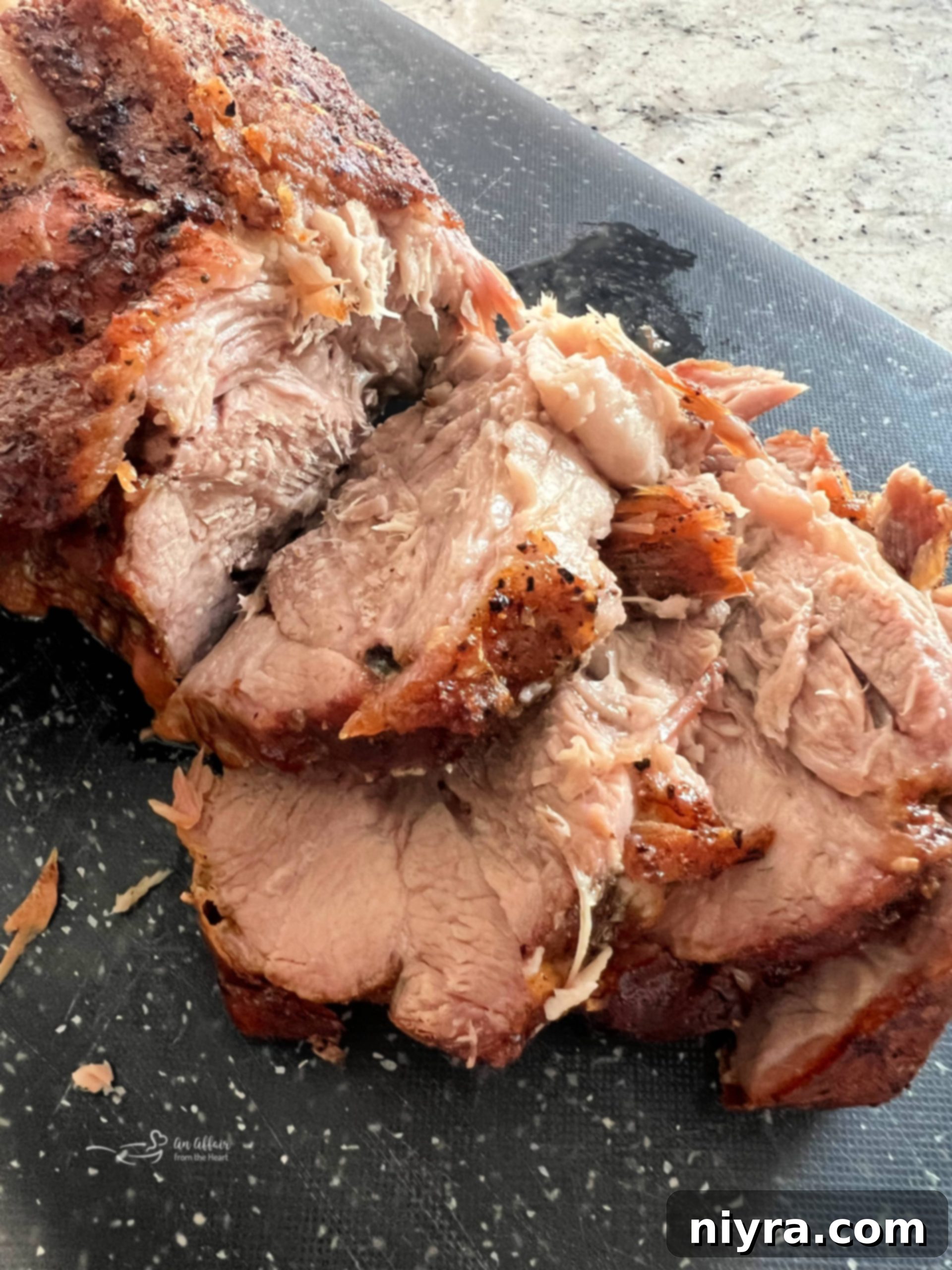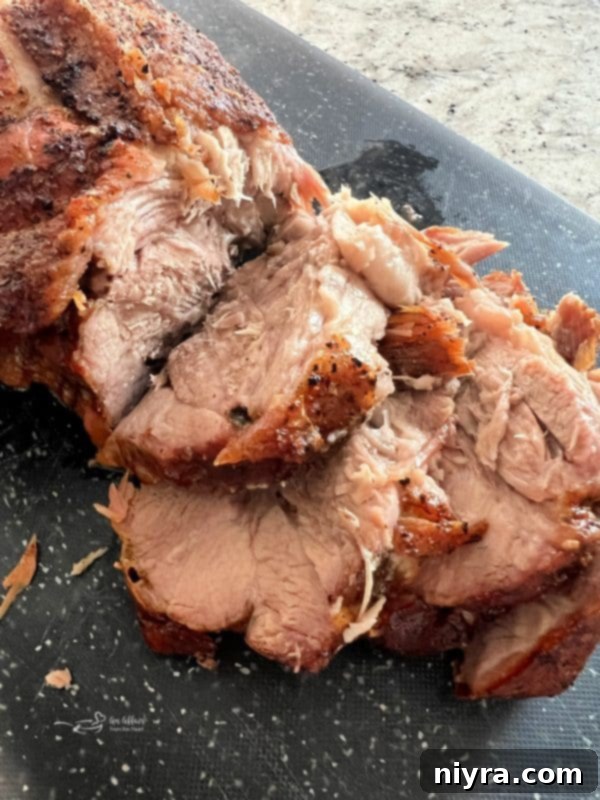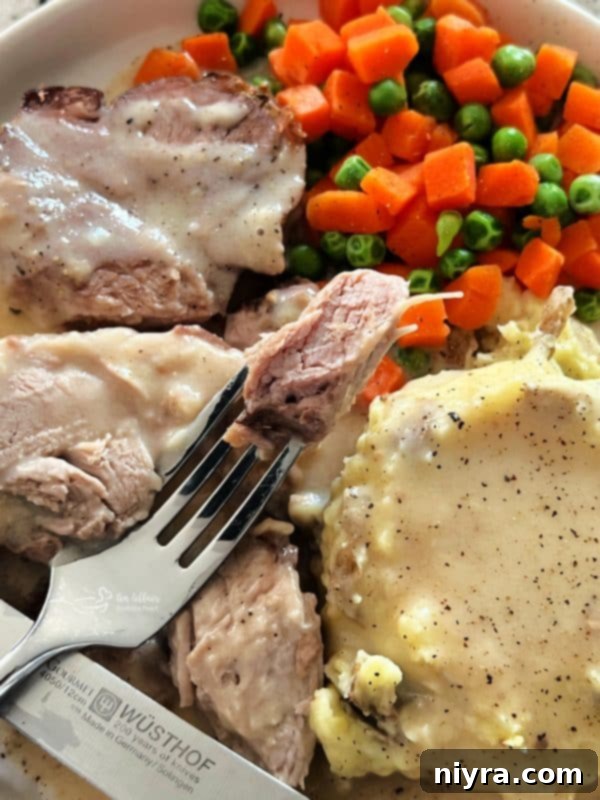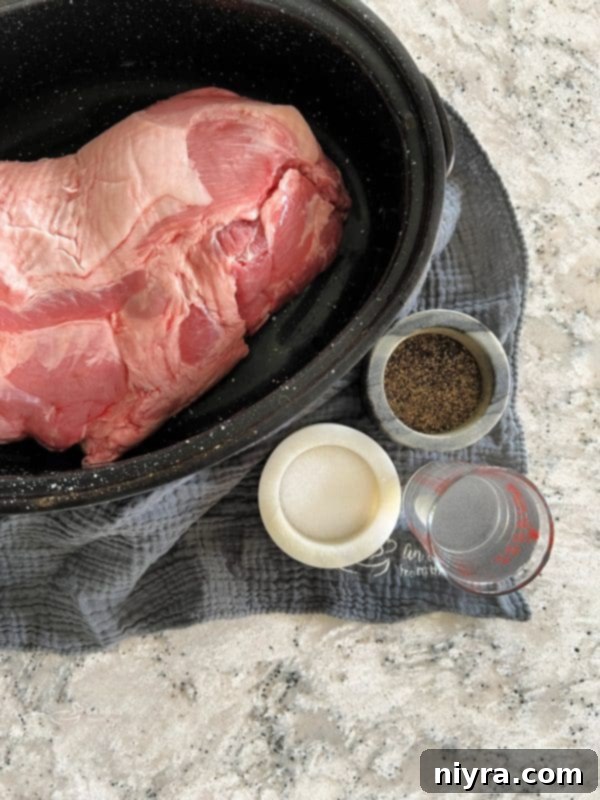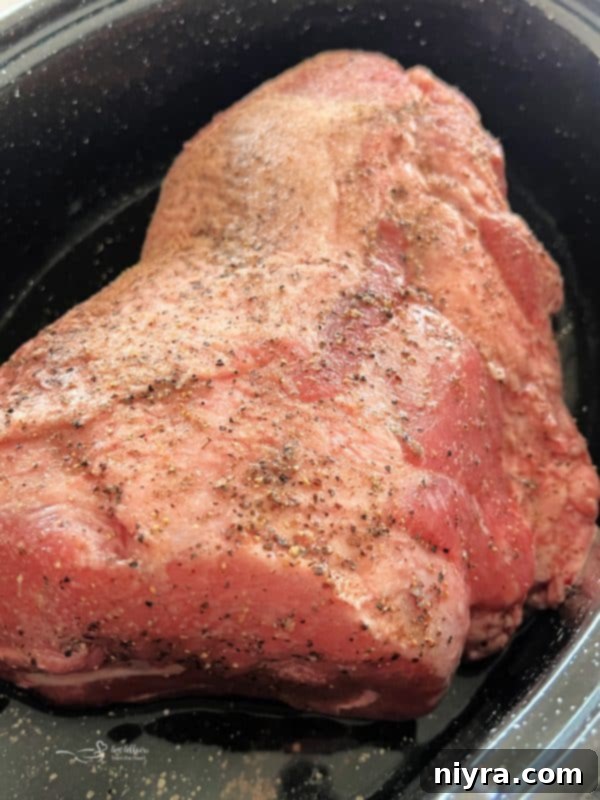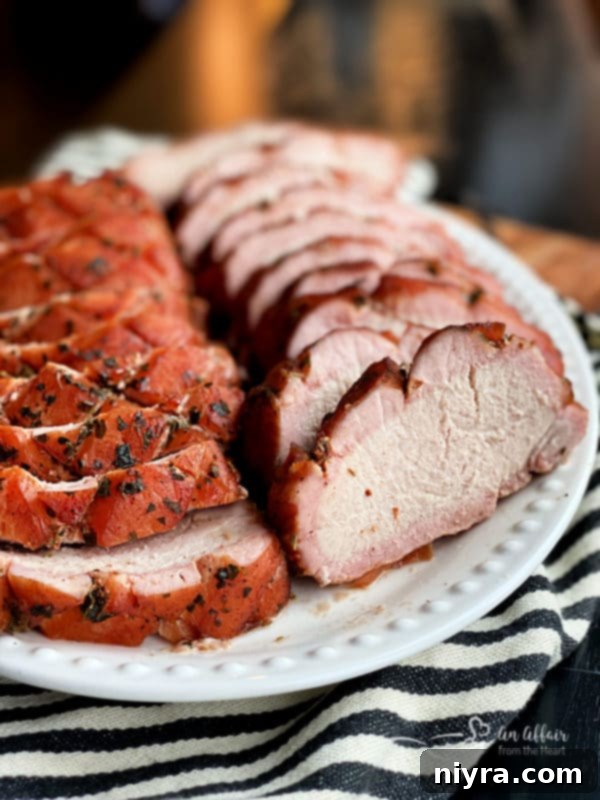Welcome to the ultimate guide for preparing a truly remarkable roasted Pork Roast and Gravy. This cherished recipe, passed down through generations, promises a succulent, fork-tender roast enveloped in a rich, deeply flavorful gravy that’s nothing short of culinary perfection. Imagine the aroma filling your home, signaling a meal that embodies comfort, tradition, and pure satisfaction. Perfect for a hearty Sunday dinner or any special occasion, this dish is guaranteed to bring smiles to your family’s faces, especially when served alongside a mountain of fluffy mashed potatoes. Get ready to create a meal that will be remembered and requested for years to come.

If the idea of crafting a magnificent pork roast and homemade gravy from scratch in your own oven seems daunting, consider this your invitation to dive in. This isn’t just a recipe; it’s a culinary legacy, learned from my mother, who learned it from hers. There’s a magic that happens when this dish bakes – the heavenly scent wafts through the house, immediately triggering those comforting feelings and making your tummy rumble in anticipation. The crowning glory is undoubtedly the homemade gravy, a silken, savory concoction born from the pan drippings, elevating the entire meal to an unforgettable comfort food experience I’ve cherished my entire life.
Slow-Roasted Pork Roast and Rich Homemade Gravy
Crafted with just a handful of straightforward ingredients, this pork roast and gravy recipe relies on a gentle, low-temperature cooking method. This ensures that the pork cooks slowly, transforming into incredibly tender, fall-off-your-fork chunks of meat. As the roast slowly cooks, it releases its savory juices, which then become the foundation for an unbelievably rich and thick gravy. This decadent gravy is made directly from the flavorful pan drippings, capturing every essence of the roast. Pair this magnificent main course with a crisp fresh green salad or some warm, creamy mashed potatoes, and you have a perfectly balanced, utterly satisfying meal that feels both gourmet and homely.
This post is proudly sponsored by Iowa Pork. All opinions expressed, as well as my lifelong devotion to delicious pork recipes and the quality of Iowa Pork, are entirely my own.
Classic Old-Fashioned Pork Roast and Gravy: A Timeless Family Favorite
This classic pork roast and gravy recipe effortlessly balances elegance with simplicity, making it a stellar choice for virtually any occasion. It’s sophisticated enough for a formal dinner party or a celebratory gathering, yet wonderfully straightforward for a relaxed Sunday night supper. You simply can’t go wrong when you serve this dish – it’s a guaranteed crowd-pleaser that embodies timeless culinary appeal. Its versatility is truly one of its greatest assets.
One of the many benefits of this recipe is its excellent make-ahead potential. You can prepare it in advance, allowing you the flexibility to tick off other items on your to-do list without sacrificing flavor or quality. Reheating it the next day is a breeze, and remarkably, the flavors often deepen and become even more pronounced. While leftovers are indeed a treat – perfect for hearty sandwiches, savory tacos, or even a quick pork stew – you might find yourself surprisingly short on them, as this delicious roast tends to disappear quickly!
If this deeply satisfying pork roast with its rich gravy has captured your heart, then you’re sure to adore these other fantastic pork recipes from my kitchen: for a twist on tradition, try The Forgotten Pork Roast, or savor the sweet and smoky notes of an Apple Glazed Smoked Ham. And for a crispy, comforting meal, these Breaded Pork Cutlets are simply divine. Each offers a unique way to enjoy the incredible versatility of pork.
Mastering the Perfect Pork Roast: Low and Slow
Achieving a truly tender and juicy pork roast is a culinary art, and for this particular recipe, the secret lies in roasting the pork at a consistently low temperature for several hours. This “low and slow” method allows the connective tissues within the meat to gradually break down, resulting in a remarkably soft, succulent, and melt-in-your-mouth texture. It’s a process that requires patience, but the rewards are absolutely worth it.
You might be tempted to crank up the oven temperature to expedite the cooking process, but I strongly advise against it. Higher heat can cause the exterior to dry out before the interior reaches optimal tenderness, compromising the overall quality of your roast. The goal here is gentle heat that works its magic over time. If your schedule demands a quicker meal, rest assured there are fantastic pork recipes that cook up much faster, such as this vibrant Sweet Balsamic Glazed Pork Tenderloin or the elegant Pork Loin Roast With Balsamic Cranberry Sauce. However, for that incomparable tenderness and rich gravy, the low and slow method for a pork shoulder roast is king.
Essential Ingredients for Your Homemade Pork Roast and Gravy
Creating this delicious pork roast and its accompanying rich gravy requires just a few quality ingredients, most of which you likely already have on hand. For a complete list of precise measurements and detailed instructions, please refer to the printable recipe card at the very bottom of this post.
For the Perfect Roast:
- Pork Shoulder Roast: The star of our dish! Aim for a roast weighing between 4 and 5 pounds. A bone-in pork shoulder will typically yield a more flavorful and moist roast due to the bone marrow, but a boneless pork roast works equally well and can be easier to carve. This cut, also known as Boston butt or picnic roast, is ideal for slow roasting due to its marbling and connective tissue, which break down beautifully into tender meat.
- Salt & Pepper: Simple yet crucial. Freshly ground black pepper and a good quality salt are essential for seasoning the pork generously, enhancing its natural flavors and contributing to that desirable crispy crust.
- Water: A small amount added to the roasting pan creates a moist environment, prevents drippings from burning, and forms the initial base for your incredibly flavorful gravy.
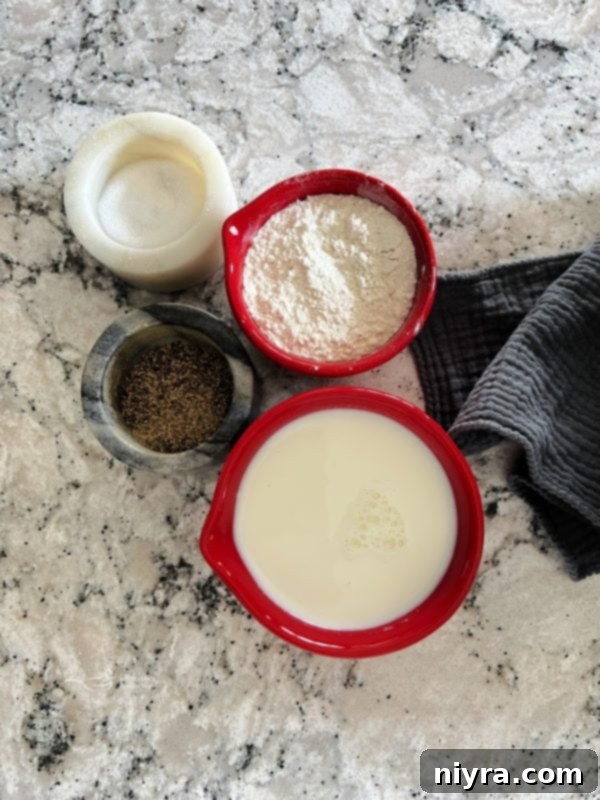
To Craft the Delectable Gravy:
- Water: While plain water can be used, a fantastic trick for an even richer gravy is to use the starchy water from boiling potatoes. About 30 minutes before your roast is ready, boil your potatoes for mashed potatoes, then reserve the cooking water. This adds an extra layer of flavor and helps thicken the gravy.
- Milk: Any type of milk will work beautifully to create a creamy, smooth gravy. For an extra rich and indulgent gravy, consider using whole milk or even a touch of half-and-half. Skim milk will result in a lighter, less creamy texture.
- All-Purpose Flour: This is your thickening agent. Combined with milk, it creates a slurry that will transform your pan drippings into a luscious, perfectly thickened gravy.
- Salt and Black Pepper: These are added to taste, allowing you to perfectly season your gravy and bring out its full depth of flavor after it has thickened.
How to Cook a Pork Roast to Perfection in the Oven
Preparing this magnificent pork roast is a straightforward process, broken down into a few simple and easy-to-follow steps. Precision and patience are key to achieving that desirable fork-tender texture and deeply flavored gravy.

Begin by preheating your oven to a steady 325 degrees Fahrenheit (160 degrees Celsius). Place your pork shoulder roast directly into a sturdy roasting pan. Generously sprinkle the entire surface of the roast with salt and freshly ground black pepper, ensuring you rub the seasoning thoroughly into the meat. This initial seasoning is crucial for building flavor and creating a delicious crust.

Next, carefully pour about half a cup of water into the bottom of the roasting pan, around the roast. This water will help keep the roast moist, prevent the pan drippings from burning, and form the flavorful foundation for your gravy.
Place the uncovered roasting pan into your preheated oven. Bake the roast for approximately 20 minutes per pound, or until its internal temperature reaches 145 degrees Fahrenheit (63 degrees Celsius) when measured with a reliable meat thermometer inserted into the thickest part of the meat, avoiding the bone. For a roast of around 4-5 pounds, this typically takes about 2.5 to 3 hours. The beauty of cooking uncovered at this temperature is that it allows the exterior to develop a beautiful, rich brown crust while keeping the interior incredibly moist.
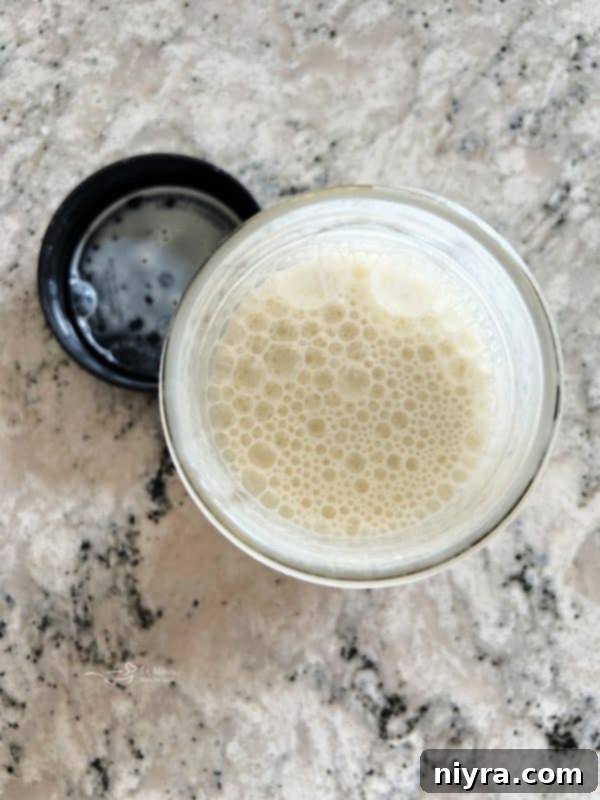
Once the roast is nearing completion, it’s time to prepare your homemade gravy. In a jar or a small bowl, combine the milk and all-purpose flour. Whisk or shake vigorously until all lumps are completely gone and you have a smooth, pourable slurry. An emulsion blender is also a fantastic tool for achieving a perfectly smooth mixture without any effort.
Carefully remove the perfectly cooked pork roast from the roasting pan and transfer it to a cutting board or serving platter. It is crucial to let the roast rest for at least 10-15 minutes before carving. This resting period allows the juices to redistribute throughout the meat, ensuring every slice is as moist and tender as possible.
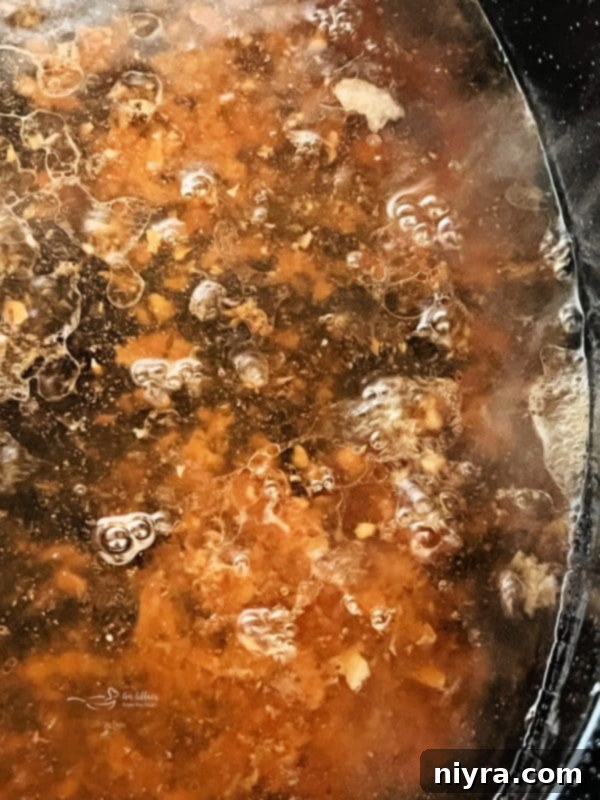
Now, place the roasting pan, complete with all those flavorful pork drippings, directly onto your stovetop over medium heat. Add an additional 2 cups of water. If you’ve boiled potatoes for mashed potatoes, this is the perfect opportunity to use that starchy potato water for an extra layer of flavor and natural thickening. Bring the mixture to a slow boil, gently scraping up any browned bits from the bottom of the pan with a wooden spoon or spatula – these bits are pure flavor!

Once the pan drippings are gently bubbling, slowly pour in the prepared milk and flour mixture (your slurry) while continuously whisking. This ensures the flour disperses evenly and prevents lumps.

Continue whisking until the slurry is fully incorporated and the gravy begins to thicken. Reduce the heat to low and allow the gravy to simmer gently for a few minutes, continuing to whisk occasionally.
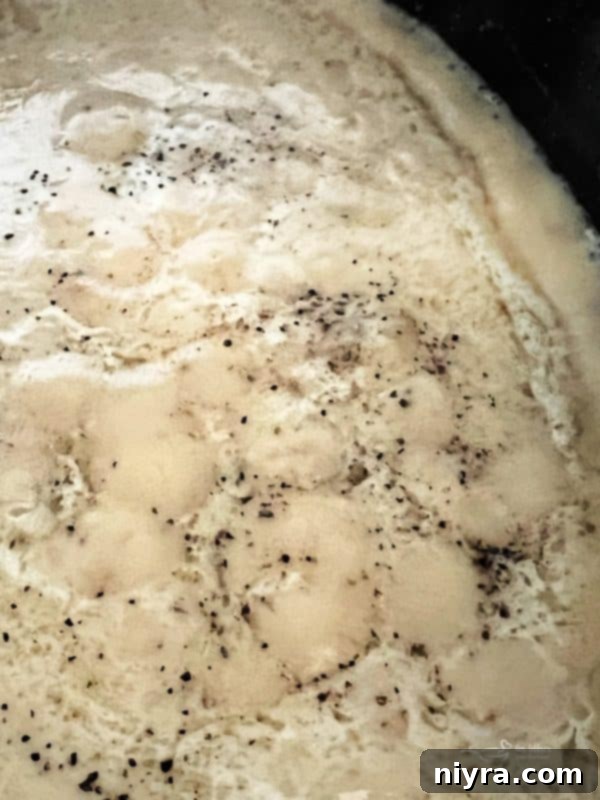
The gravy will continue to thicken beautifully as it cooks down. Taste the gravy and adjust the seasoning with additional salt and pepper as needed, ensuring it’s perfectly balanced to your preference.
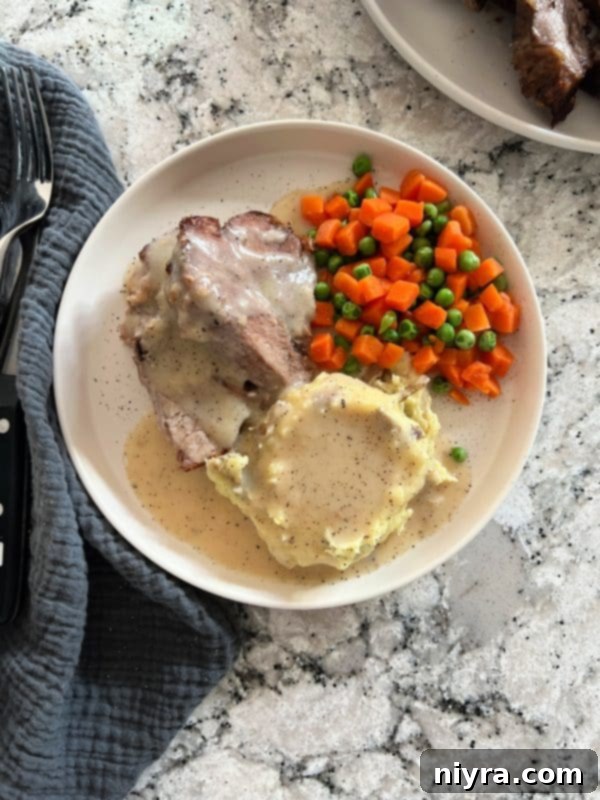
Carve your tender pork roast and serve generous portions alongside a generous helping of creamy mashed potatoes. Don’t forget to ladle plenty of that rich, homemade gravy over everything for a truly unforgettable meal!
A Note on Cooking Time and Internal Temperature: While general guidelines suggest 20 minutes per pound at 325 degrees, cooking times can vary based on your oven and the specific cut of pork. My almost 5-pound Pork Shoulder Roast, for instance, cooked perfectly uncovered for 2 ½ hours at 325 degrees. It achieved an internal temperature of 170 degrees Fahrenheit, resulting in a beautifully brown and crisp exterior, while the inside remained wonderfully moist and tender. That rich, brown crust on the outside isn’t just for show; it contributes immense flavor to the pan drippings, which in turn creates the absolute best pork gravy! Always use a meat thermometer for accuracy.
Storing Leftovers: Any leftover tender pork roast should be allowed to cool to room temperature before storing. Wrap it tightly in aluminum foil or place it in an airtight container and refrigerate for up to 3 days. For longer storage, this delectable roast freezes beautifully for up to 3 months. To freeze, slice or shred the pork, place it in a freezer-safe bag or container, and consider adding some extra gravy to keep it moist. Thaw in the refrigerator overnight before reheating gently.
Loved This Recipe? Pin It for Later!
If you’re as enamored with this incredible roast pork and gravy recipe as we are, make sure you don’t lose it! Pin it directly to your favorite Pinterest recipe board now, so you can easily find it whenever that comfort food craving strikes.
Understanding the Pork Shoulder Roast
The pork shoulder is a truly remarkable cut of meat, renowned for its ability to transform into an exquisitely tender and flavor-packed dish when cooked using the right techniques. Its inherent versatility makes it a favorite among chefs and home cooks alike, lending itself beautifully to a wide array of recipes. While preparing pork shoulder is relatively simple, knowing what to look for when selecting it at the meat counter can make all the difference.
You’ll often find the pork shoulder cut labeled under various names at your local grocery store or butcher shop. Common monikers include “picnic roast,” “Boston butt,” “blade roast,” and simply “pork butt.” Despite the confusing array of names, these all refer to parts of the pork shoulder. This incredibly versatile cut is perfect for diverse cooking methods, from long braises and slow smoking to traditional roasting, grilling, and, of course, slow cooking. Pork shoulder is particularly popular and highly favored for creating the ultimate pulled pork, thanks to its ideal fat content and connective tissues that render down beautifully during extended cooking.
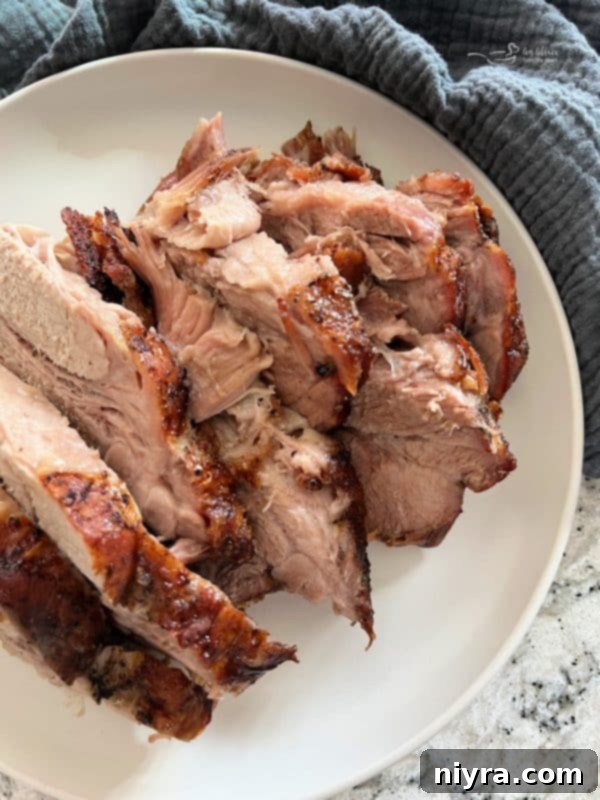
Frequently Asked Questions About Roast Pork
- Does pork roast get more tender the longer you cook it? Yes, generally, pork roast becomes more tender with extended cooking, especially when cooked at a low temperature. The low heat and prolonged cooking time allow the collagen and connective tissues in the meat to break down into gelatin, resulting in that desirable fork-tender texture. However, it’s crucial not to overcook it to the point of drying it out, which can happen if cooked too long at too high a temperature.
- Is it better to cook a pork roast slow or fast? The optimal cooking method for a pork roast truly depends on the specific cut of meat and the desired outcome. For cuts like pork shoulder or butt, which have more fat and connective tissue, a “low and slow” cooking method is almost always superior for achieving maximum tenderness and juiciness. Faster, higher-heat methods are typically reserved for leaner cuts like tenderloin, where the goal is a quick sear and a slightly pink interior.
- Is it best to cook a pork roast covered or uncovered? For this recipe, I always advocate for cooking your pork roast uncovered. This method allows the exterior of the roast to achieve a beautiful, savory brown crust, which not only adds a super tasty “crunch” but also contributes significantly to the rich, deep flavor of the pan drippings – an essential component of a truly outstanding gravy. Covering the roast might keep it moist but would prevent this crucial browning.
- Do I need to sear the pork roast before roasting? For this particular slow-roasted pork shoulder recipe, searing the pork before placing it in the oven is not necessary. The long, uncovered roasting time at a moderate temperature naturally develops a wonderful brown crust, eliminating the need for an extra searing step and simplifying the preparation.
- What is the best way to cook pork so it is tender? As mentioned, slow cooking at a low temperature is generally the best method for achieving incredibly tender pork, especially for cuts that benefit from it, like shoulder, butt, or even ribs. The key is to match the cooking method to the specific cut of meat and the recipe’s desired texture.
- How long to cook a 4 lb pork roast at 250 degrees Fahrenheit? Cooking times can vary significantly based on whether your 4-pound roast is bone-in or boneless, and its exact thickness. As a general guide, a bone-in pork shoulder roast of this size might require anywhere from 6 to 8 hours at 250 degrees F, while a boneless cut would typically need around 3 to 4 hours. Always rely on a meat thermometer to confirm doneness, aiming for at least 145°F for food safety, though many prefer pork shoulder cooked to 170-190°F for maximum tenderness and shredability.
- Can I add vegetables to the roasting pan? Absolutely! Adding hearty vegetables like chopped carrots, onions, celery, or potatoes to the roasting pan during the last hour or two of cooking can infuse them with incredible pork flavor and provide a wonderful side dish. They also contribute to the deliciousness of the pan drippings for your gravy.
- What if my gravy is too thin or too thick? Troubleshooting gravy is easy! If your gravy is too thin, create a small slurry with equal parts flour (or cornstarch for a gluten-free option) and cold water, then whisk it gradually into the simmering gravy until it reaches your desired consistency. If it’s too thick, simply whisk in a little more water, milk, or broth until it thins out to perfection.
Creative Substitutions for Your Pork Roast Recipe
Remember, cooking is an adventure in creativity! Don’t hesitate to get inventive with substitutions in your recipes, choosing ingredients that perfectly match your personal taste, what you have on hand, or any dietary preferences. Make this recipe truly your own!
For a Gluten-Free Gravy: If you prefer a gluten-free option or a slightly different texture, use cornstarch instead of all-purpose flour for your slurry. Mix cornstarch with an equal amount of cold water to create a smooth paste, then gradually whisk it into the hot pork drippings. Cornstarch thickens more powerfully than flour, so start with half the amount and add more if needed.
Switch Up the Pork Cut: While pork shoulder is highly recommended for its tenderness and flavor, you can certainly experiment with other cuts. A pork butt will yield similar results, while a pork loin roast, being leaner, will cook faster and require careful monitoring to prevent drying out. Adjust your cooking time and temperature accordingly when using a different cut.
Dairy-Free Gravy Options: For a delicious dairy-free gravy, replace the milk with an equal amount of chicken broth, beef stock, or even vegetable broth. Each will impart a slightly different but equally delicious flavor profile to your gravy. Ensure your flour or cornstarch slurry is made with cold broth instead of milk.
Aromatic Enhancements for the Roast: Beyond salt and pepper, consider rubbing the pork with a blend of dried herbs like rosemary, thyme, or sage for an extra layer of rustic flavor. You could also include a touch of smoked paprika for depth.
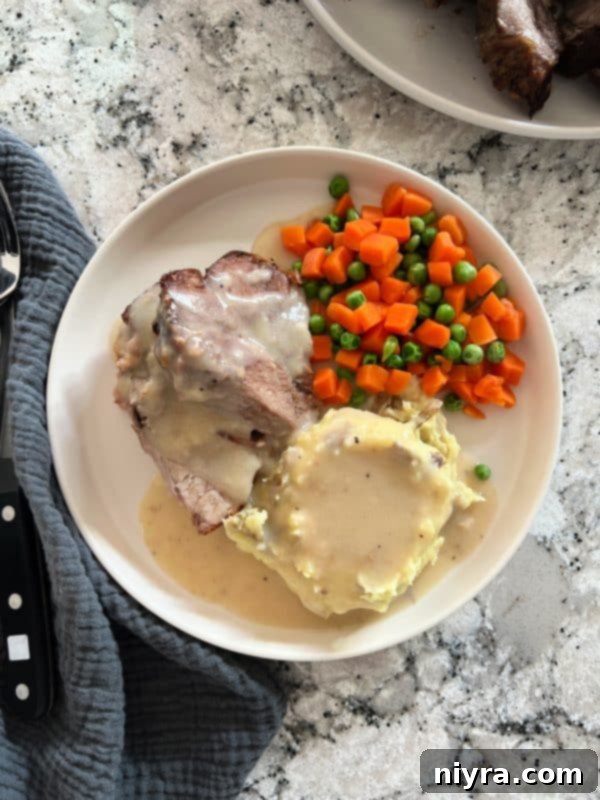
Expert Tips & Tricks for the Best Pork Roast and Gravy
Elevate your pork roast and gravy from great to extraordinary with these helpful tips and tricks, designed to maximize flavor and ensure perfect results every time.
Bring Pork to Room Temperature: For more even cooking, remove your pork roast from the refrigerator about 30-60 minutes before you plan to put it in the oven. Allowing it to come closer to room temperature helps the meat cook more uniformly, preventing the outside from overcooking before the inside is done.
Enhance Seasoning: While salt and pepper are fundamental, consider adding extra layers of flavor to your pork. A sprinkle of garlic powder and onion powder along with the salt and pepper before roasting can add a delicious aromatic depth that complements the pork beautifully. You might also experiment with a pinch of paprika or a dried herb blend.
Deglaze for Deeper Gravy Flavor: After removing the roast from the pan, and before adding water for the gravy, you can deglaze the pan with a splash of dry white wine or chicken broth. Scrape up all the browned bits from the bottom of the pan while it’s still hot on the stovetop. These “fonds” are packed with incredible flavor and will significantly enhance your gravy.
Perfect Gravy Consistency: If your gravy needs a bit more body, continue to simmer it gently on low heat, stirring frequently, to reduce it slightly. If it becomes too thick, simply whisk in a tablespoon of milk, water, or broth at a time until it reaches your desired consistency. Always taste and adjust seasoning after any additions.
Fresh Herbs for Garnish: A sprinkle of fresh chopped parsley, rosemary, or thyme over the finished roast and gravy not only adds a beautiful pop of color but also a burst of fresh, aromatic flavor.
My Enduring Love of Pork: From Childhood Dinners to Nutritional Wisdom
My connection to pork runs deep, intertwined with cherished family meals and traditions. Even though I didn’t grow up on an Iowa farm like my husband did, pork was a staple at our dinner table. I fondly remember my Mom’s Pork Chops and Mushroom Gravy as one of my ultimate comfort meals during childhood, and it’s a recipe I proudly continue to make for my own children today. Little do they know, as they savor these delicious pork creations, I’m internally smiling, fully aware of the impressive nutritional value of pork. It’s a lean, protein-packed source of essential vitamins and minerals like thiamin, niacin, riboflavin, Vitamin B6, phosphorus, zinc, and selenium, making it a wholesome and delicious choice for family meals.
Discover More Delightful Pork Recipes to Love
Pork offers an incredible array of cuts, each lending itself to unique and delicious culinary creations. My website is a treasure trove of pork recipes, showcasing the versatility of this beloved meat. Remember that different cuts require specific cooking techniques and distinct internal cooking temperatures to achieve optimal flavor and texture. Thankfully, resources like the Iowa Pork Cooking Temperature Guide make it incredibly easy to ensure your pork is cooked perfectly and safely every time.
Explore these other mouth-watering pork dishes to expand your culinary repertoire:
- Smoked Pork Loin (pictured above): A tender, flavorful roast with a beautiful smoky essence.
- Ham & Bean Soup: A comforting and hearty classic, perfect for chilly days.
Breaded Pork Tenderloin Sandwich: A crispy, juicy sandwich that’s a true Midwest favorite.
BBQ Pork Ribs: Finger-licking good ribs, slow-cooked to perfection with a tangy BBQ sauce.
Baked Pork Chops With Stuffing: A complete and satisfying meal, baked to golden brown goodness.
Dr. Pepper Pork Ribs: An adventurous and incredibly tender rib recipe with a unique sweet and savory glaze.

Be sure to follow along with Iowa Pork on Instagram, Facebook, Pinterest, and Twitter for a continuous stream of delicious pork recipes and culinary inspiration year-round!

This straightforward yet incredibly rewarding recipe ensures your pork roast is slow-cooked to absolute perfection, resulting in tender, succulent meat. Crowned with a rich, thick, and utterly delicious homemade gravy, this dish is destined to become a cherished family favorite that will have everyone eagerly asking for second helpings.

LIKE THIS RECIPE?
Don’t forget to give it a ⭐️⭐️⭐️⭐️⭐️ star rating and
leave a comment below the recipe!
Pork Roast and Gravy
This easy recipe for roasted Pork Roast and Gravy delivers a fork-tender roast covered in a beautiful gravy that’s perfect for Sunday dinner. The cooking process provides a perfectly seared pork roast, which makes the most flavorful gravy. Serve it up with some fluffy mashed potatoes and watch your family grin from ear to ear.
3 mins
3 hrs
3 hrs 3 mins
Equipment
- 12-Piece Black Sharp Knife Set with Covers, Cutting Board and Sharpener
- Granite Ware Covered Oval Roaster, 13 inches, Black
- Lodge 6 Quart Enameled Cast Iron Dutch Oven. Classic Red Enamel Dutch Oven (Island Spice Red)
- Whisks for Cooking, 3 Pack Stainless Steel Whisk
Ingredients
For the Roast:
- 4 lbs Pork Shoulder Roast (4-5 pounds)
- 1 ½ – 2 teaspoons salt
- 1 teaspoon pepper
- ½ cup water
For the Gravy:
- 2 cups water
- 1 ¼ cups milk
- ½ cup flour
- Salt and Pepper (to taste)
Instructions
- Preheat oven to 325 degrees F (160 C). Place roast in a roasting pan, sprinkle with salt and pepper, and rub into the roast. Add water to the bottom of the pan.
- Place the roaster, uncovered in the preheated oven, and bake for about 20 minutes per pound or until the internal temperature of the roast reads 145 degrees F (63 C). *See notes below for more detail.
- In a jar or small bowl, mix together milk and flour until all lumps are gone. (Shaking or using an emulsion blender works great).
- Remove the roast from the pan and set it aside to rest. Place the roasting pan on the stovetop over medium heat. Add 2 cups of water (using potato water from mashed potatoes is optional but recommended). Bring to a slow boil, scraping up any browned bits from the pan.
- Pour the milk mixture into the bubbling drippings and whisk continuously until incorporated. Turn the heat to low. The gravy will thicken as it cooks.
- Serve the roast with mashed potatoes and plenty of gravy on top.
